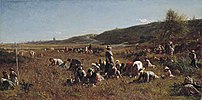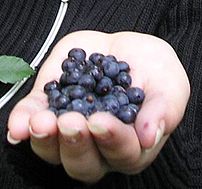Botanical Name :Vaccinium myrtillus
Family: Vacciniaceae/Ericaceae
Genus: Vaccinium
Species: V. myrtillus
Kingdom: Plantae
Order: Ericales
Synonyms:Whortleberry. Black Whortles. Whinberry. Trackleberry. Huckleberry. Hurts. Bleaberry. Hurtleberry. Airelle. Vaccinium Frondosum. Blueberries.
Common Names: bilberry, European blueberry, whortleberry, huckleberry
Parts Used:The ripe fruit. The leaves.
Habitat: Vaccinium myrtillus is native to Europe, including Britain, from Iceland south and east to Spain, Macedonia, the Caucasus and N. Asia . It grows in heaths, moors and woods on acid soils to 1250 metres.
Description:
Vaccinium myrtillus is a deciduous Shrub. It grows abundantly in the heathy and mountainous districts, a small branched shrub, with wiry angular branches, rarely over a foot high, bearing globular wax-like flowers and black berries, which are covered when quite ripe with a delicate grey bloom, hence its name in Scotland, ‘Blea-berry,’ from an old North Countryword, ‘blae,’ meaning livid or bluish. The name Bilberry (by some old writers ‘Bulberry’) is derived from the Danish ‘bollebar,’ meaning dark berry. There is a variety with white fruits.
The leathery leaves (in form somewhat like those of the myrtle, hence its specific name) are at first rosy, then yellowish-green, and in autumn turn red and are very ornamental. They have been utilized to adulterate tea.
click to see the pictures >……....(1)……..(2)....(3)…..(4)..….…………………
Bilberries flourish best on high grounds, being therefore more abundant in the north and west than in the south and east of England: they are absent from the low-lying Cambridgeshire and Suffolk, but on the Surrey hills, where they are called ‘Hurts,’ cover the ground for miles.
The fruit is globular, with a flat top, about the size of a black currant. When eaten raw, they have a slightly acid flavour. When cooked, however, with sugar, they make an excellent preserve. Gerard tells us that ‘the people of Cheshire do eate the black whortles in creame and milke as in these southern parts we eate strawberries.’ On the Continent, they are often employed for colouring wine.
Stewed with a little sugar and lemon peel in an open tart, Bilberries make a very enjoyable dish. Before the War, immense quantities of them were imported annually from Holland, Germany and Scandinavia. They were used mainly by pastrycooks and restaurant-keepers.
Species:
Bilberries include several closely related species of the Vaccinium genus, including:
*Vaccinium myrtillus L. (bilberry)
*Vaccinium uliginosum L. (bog bilberry, bog blueberry, bog whortleberry, bog huckleberry, northern bilberry, ground hurts)
*Vaccinium caespitosum Michx. (dwarf bilberry)
*Vaccinium deliciosum Piper (cascade bilberry)
*Vaccinium membranaceum (mountain bilberry, black mountain huckleberry, black huckleberry, twin-leaved huckleberry)
*Vaccinium ovalifolium (oval-leafed blueberry, oval-leaved bilberry, mountain blueberry, high-bush blueberry).
Edible Uses:
Owing to its rich juice, the Bilberry can be used with the least quantity of sugar in making jam: half a pound of sugar to the pound of berries is sufficient if the preserve is to be eaten soon. The minuteness of the seeds makes them more suitable for jam than currants.
Recipe for Bilberry Jam—
Put 3 lb. of clean, fresh fruit in a preserving pan with 1 1/2 lb. of sugar and about 1 cupful of water and bring to the boil. Then boil rapidly for 40 minutes. Apple juice made from windfalls and peelings, instead of the water, improves this jam. To make apple juice, cover the apples with water, stew down, and strain the juice through thick muslin. Blackberries may also be added to this mixture.
If the jam is to be kept long it must be bottled hot in screw-top jars, or, if tied down in the ordinary way, more sugar must be added.
Bilberry juice yields a clear, dark-blue or purple dye that has been much used in the dyeing of wool and the picking of berries for this purpose, as well as for food, constitutes a summer industry in the ‘Hurts’ districts. Owing to the shortage of the aniline dyestuffs formerly imported from Germany, Bilberries were eagerly bought up at high prices by dye manufacturers during the War, so that in 1917 and 1918 a large proportion of the Bilberry crop was not available for jam-making, as the dyers were scouring the country for the little blue-black berries.
Wild and cultivated harvesting:-
Bilberries are found in very acidic, nutrient-poor soils throughout the temperate and subarctic regions of the world. They are closely related to North American wild and cultivated blueberries and huckleberries in the genus Vaccinium. One characteristic of bilberries is that they produce single or paired berries on the bush instead of clusters, as the blueberry does.
The fruit is smaller than that of the blueberry but with a fuller taste. Bilberries are darker in colour, and usually appear near black with a slight shade of purple. While the blueberry’s fruit pulp is light green, the bilberry’s is red or purple, heavily staining the fingers and lips of consumers eating the raw fruit. The red juice is used by European dentists to show children how to brush their teeth correctly, as any improperly brushed areas will be heavily stained.
Bilberries are extremely difficult to grow and are thus seldom cultivated. Fruits are mostly collected from wild plants growing on publicly accessible lands, notably Finland, Sweden, Norway, Iceland, Scotland, Wales, Ireland, parts of England, Alpine countries, Carpathian Mountains in Ukraine, Belarus, Romania, Bulgaria, Poland and northern parts of Turkey and Russia. Note that in Austria, Finland, Norway, Sweden and Switzerland, it is an everyman’s right to collect bilberries, irrespective of land ownership, with the exception of private gardens. Bilberries can be picked by a berry-picking rake like lingonberries, but are more susceptible to damage. Bilberries are softer and juicier than blueberries, making them difficult to transport. Because of these factors, the bilberry is only available fresh in gourmet stores, where they can cost up to 25 Euro per pound. Frozen bilberries however are available all year round in most of Europe.
In Finland, bilberries are collected from forests. They are eaten fresh or can be made in different jams, and dishes. The famous one is Mustikkapiirakka, bilberry pie
In Ireland, the fruit is known as fraughan, from the Irish fraochán, and is traditionally gathered on the last Sunday in July, known as Fraughan Sunday.
Bilberries were also collected at Lughnassadh in August, the first traditional harvest festival of the year, as celebrated by Gaelic people. The crop of bilberries was said to indicate how well the rest of the crops would fare in their harvests later in the year.
The fruits can be eaten fresh or made into jams, fools, juices or pies. In France and in Italy, they are used as a base for liqueurs and are a popular flavoring for sorbets and other desserts. In Brittany, they are often used as a flavoring for crêpes, and in the Vosges and the Massif Central bilberry tart (tarte aux myrtilles) is a traditional dessert.
Constituents:
Quinic acid is found in the leaves, and a little tannin. Triturated with water they yield a liquid which, filtered and assayed with sulphate of iron, becomes a beautiful green, first of all transparent, then giving a green precipitate.
The fruits contain sugar, etc. Bilberries contains approximately 0.5% by volume of the anthocyanosides, they also contain the vitamins B1 and C, pro-vitamin A, at least 7% by volume is composed of tannins, and assorted plant acids are also seen. The tonic effect of the anthocyanosides on the blood vessels is the beneficial to the human body.
Medicinal Uses:
Often associated with improvement of night vision, bilberries are mentioned in a popular story of World War II RAF pilots consuming bilberry jam to sharpen vision for night missions. However, a recent study by the U.S. Navy found no such effect and origins of the RAF story cannot be found.
Although the effect of bilberry on night vision is controversial, laboratory studies have provided preliminary evidence that bilberry consumption may inhibit or reverse eye disorders such as macular degeneration. A randomized, double-blind, placebo-controlled clinical trial on 50 patients suffering from senile cataract showed that a combination of bilberry extract and vitamin E administered for 4 months was able to stop lens opacity progress in 97% of the cataracts.
As a deep purple fruit, bilberries contain high levels of anthocyanin pigments, which have been linked experimentally to lowered risk for several diseases, such as those of the heart and cardiovascular system, eyes, diabetes and cancer.
In folk medicine, bilberry leaves were used to treat gastrointestinal ailments, applied topically, or made into infusions. Bilberries are also used as a tonic to prevent some infections and skin diseases.
•Historically, bilberry fruit was used to treat diarrhea, scurvy, and other conditions.
•Today, the fruit is used to treat diarrhea, menstrual cramps, eye problems, varicose veins, venous insufficiency (a condition in which the veins do not efficiently return blood from the legs to the heart), and other circulatory problems.
•Bilberry leaf is used for entirely different conditions, including diabetes.
The leaves can be used in the same way as those of UvaUrsi. The fruits are astringent, and are especially valuable in diarrhoea and dysentery, in the form of syrup. The ancients used them largely, and Dioscorides spoke highly of them. They are also used for discharges, and as antigalactagogues. A decoction of the leaves or bark of the root may be used as a local application to ulcers, and in ulceration of the mouth and throat.
The fruit is helpful in scurvy and urinary complaints, and when bruised with the roots and steeped in gin has diuretic properties valuable in dropsy and gravel. A tea made of the leaves is also a remedy for diabetes if taken for a prolonged period.
You may click to learn more about medical benefit of bilberries :
Other Uses …..Dye; Ink…….A green dye is obtained from the leaves and the fruit and is used to colour fabrics. A blue or black dye is obtained from the fruit. This can be used as an ink.
Known Hazards: High tannin content may cause digestive disorders – avoid prolonged use or high doses. Avoid in pregnancy. Avoid if on anticoagulant therapy (e.g. warfarin)
Disclaimer:
The information presented herein is intended for educational purposes only. Individual results may vary, and before using any supplements, it is always advisable to consult with your own health care provider.
Resources:
http://www.herbs2000.com/herbs/herbs_bilberry.htm
http://botanical.com/botanical/mgmh/b/bilber37.html
http://www.elements4health.com/bilberry-health-benefits.html
http://www.pfaf.org/user/Plant.aspx?LatinName=Vaccinium+myrtillus
Related articles by Zemanta
- Bilberry: Can Bilberry Extract Improve Night Blindness? (brighthub.com)
- Top 10 blueberry destinations (gadling.com)
- The Southern Gardener: Don’t tell my neighbor, but this illicit fruit sure is sweet (commercialappeal.com)
- Pro Clinical Hydroxycut Reviews (weightlossnutrition.org)
- Isotonix OPC-3: Is This Miracle Supplement Worth Your Money? (blisstree.com)
- Tender delights: Nigel Slater’s fruit recipes from his book Tender Volume II (guardian.co.uk)
- Can I Improve My Vision Naturally? (brighthub.com)
- Anti-Acne Diet (aolhealth.com)






















